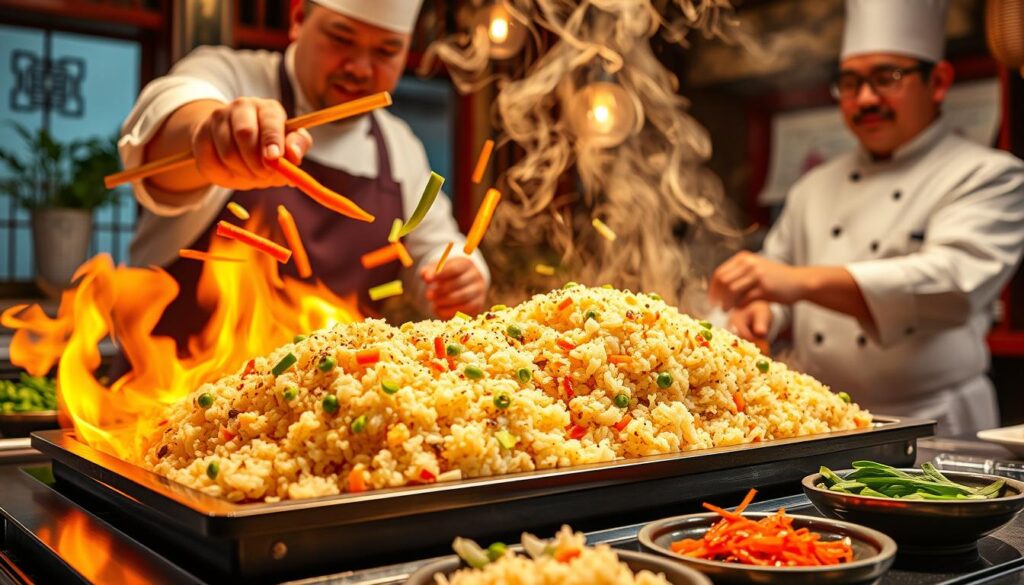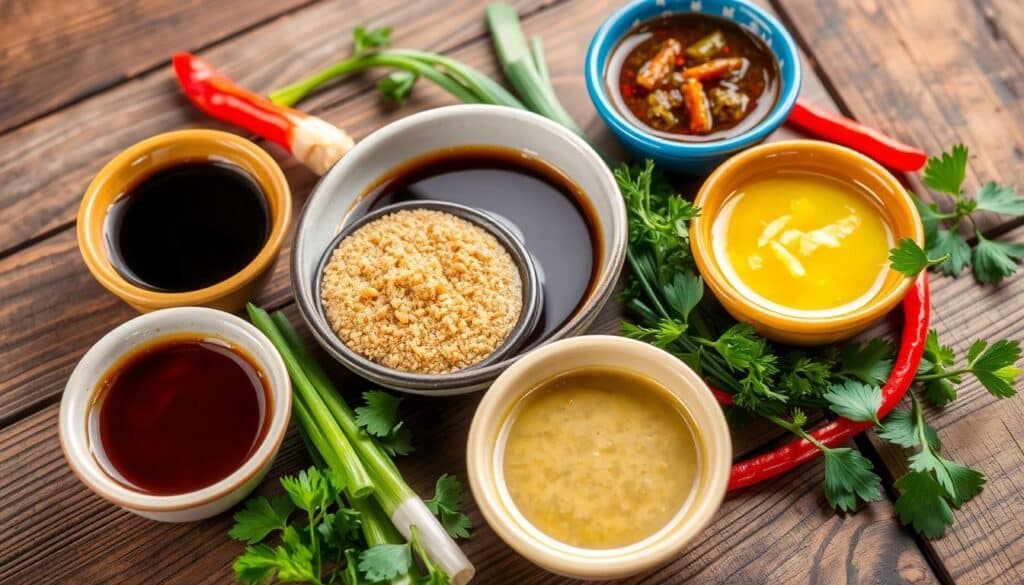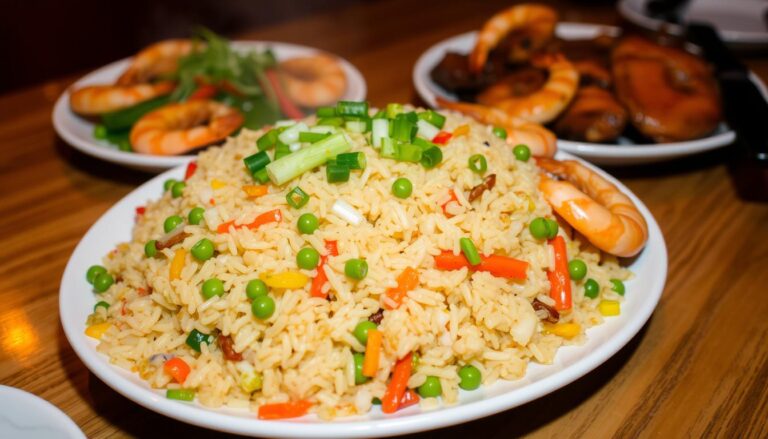Discover the magic of Japanese cooking with an easy hibachi fried rice recipe. It brings the excitement of hibachi to your kitchen. Picture the rich flavors of scrambled eggs, fresh veggies, and day-old rice coming together. This dish is perfect on its own or with chicken or steak, offering the deep flavors found in Japanese restaurants.
This hibachi wonder isn’t just tasty—it’s a smart way to use leftovers. It combines simple ingredients for big flavors, elevating home cooking. Get ready to bring the essence of Japanese food into your home, creating lasting flavor memories.
Key Takeaways
- Whip up a hibachi fried rice recipe that rivals restaurant-quality with ease at home.
- Elevate your meal by pairing the fried rice with various proteins for a comprehensive feast.
- Discover the importance of using day-old rice to achieve the perfect texture for your dish.
- Learn how simple ingredients can unfold into layers of authentic flavors typical of Japanese cuisine.
- Get to know the home cooking tips and tricks that make your hibachi experience genuinely memorable.
- Explore how additional veggies can enhance nutritional value and flavor complexity.
Exploring the Hibachi Cooking Style
Japanese cuisine is known for unique cooking styles. Among these, hibachi cooking is special for its engaging dining experience. It comes from the Japanese word ‘hibachi’, meaning ‘fire bowl’. This style uses a heat source and a bowl-shaped grate to cook food in front of guests. It blends flavor with performance, showing the art of Japanese cooking.
Origins of Hibachi
Hibachi cooking dates back centuries in traditional Japanese cuisine. It started with simple, portable devices for warmth or cooking small meals in homes. In the West, it turned into entertaining cooking. Here, chefs cook on a gas-heated hotplate in front of diners. This style has become a hit in restaurants all over.
Teppanyaki Grilling vs. Hibachi
People often mix up hibachi cooking with teppanyaki grilling, but they differ. Teppanyaki uses an iron griddle for cooking. It focuses on a variety of foods like meats, seafood, and vegetables. Teppanyaki grills are larger and aim for communal dining, unlike the traditional hibachi.
| Feature | Hibachi Cooking | Teppanyaki Grilling |
|---|---|---|
| Primary Equipment | Bowl-shaped charcoal or gas grill | Large, flat iron griddle |
| Heat Source | Direct flame from charcoal or gas | Evenly heated metal surface |
| Cooking Style | Small scale, intimate | Large scale, showmanship |
| Popular Foods | Skewered meats, vegetables | Steaks, shrimp, fried rice |
| Dining Experience | Close interaction with chef | Entertaining performance |
Whether you like the cozy feel of hibachi cooking or the exciting show of teppanyaki grilling, both offer a peek into Japanese cuisine. They highlight taste and entertainment, winning the hearts of food lovers worldwide.
What Makes Hibachi Fried Rice Unique?
The secret of hibachi fried rice is how it combines simple stuff with authentic Asian flavors. It’s different because of the rice choice. Calrose rice is preferred for being sticky yet soft. This kind of rice picks up flavors well and keeps a nice chewiness.
When you cook hibachi fried rice on a hot griddle, it gets a smoky taste. This way of cooking makes the rice a bit crispy. It’s a different style from typical Chinese fried rice, which is known for its distinct flavors and textures.
| Ingredient | Role in Hibachi Fried Rice | Comparison to Traditional Fried Rice |
|---|---|---|
| Calrose Rice | Provides a sticky texture, absorbing flavors well. | More traditional choices are jasmine or long grain rice, which are less sticky. |
| High-Heat Cooking | Develops a unique, smoky and crispy texture. | Often cooked at medium heat, which does not produce smokiness. |
| Toasted Sesame Oil | Enhances flavor with nutty accents. | Less commonly used, with a preference for lighter oils. |
If you’re into healthy eating, check out this chicken cabbage recipe. It uses similar types of rice and focuses on both taste and nutrition.
The magic of this hibachi rice comes from mixing flavors like onions and ginger with high heat. This cooking way boosts the meal’s taste with deep, authentic Asian flavors.
Hibachi Fried Rice Recipe: Ingredients You’ll Need
Making hibachi fried rice at home is easy once you know what you need. These key ingredients will add distinct flavors and textures to your meal. Get them ready for a delicious experience.
Choosing the Right Rice for Hibachi
To make outstanding hibachi fried rice, start with the rice. Use day-old rice, like brown rice, Jasmine, or Calrose. It fries well and keeps the grains separate. This prevents the rice from becoming mushy.
The Role of Soy Sauce and Toasted Sesame Oil
Soy sauce and toasted sesame oil are vital for this recipe. They add smoky flavors and depth. Choose low sodium soy sauce to keep it less salty. A hint of toasted sesame oil brings a nutty aroma, enhancing your dish.
Additional Stir-Fried Vegetables
Adding vegetables brings colors, textures, and flavors to your fried rice. Include onions, carrots, peas, and scrambled eggs. You can also add bell peppers or zucchini to make it your own.

| Ingredient | Type | Quantity |
|---|---|---|
| Rice | Brown, Jasmine, Calrose | 2 cups (day-old) |
| Soy Sauce | Low Sodium | 2 tbsp |
| Toasted Sesame Oil | N/A | 1 tbsp |
| Vegetables | Onions, Carrots, Peas | 1 cup each |
| Butter | N/A | 2 tbsp |
| Eggs | Scrambled | 3 |
Step-by-Step Guide to Making Hibachi Fried Rice
Making hibachi fried rice at home is fun and brings out rich flavors. Every step is crucial, from sautéing vegetables to getting the rice just right. It ends with a meal that looks and tastes amazing.
Preparing and Cooking the Rice
Rice is the base of this dish. Wash the rice until the water is clear to avoid clumping. Cook it so it’s a bit firmer than normal. It shouldn’t be mushy when stir-fried. Spread it out to dry, which helps get the texture perfect for your dish.
Mastering the Art of Egg Scrambling
Eggs make the rice rich and tasty. Use a bit of oil and scramble the eggs until mostly set. Remember, they cook more when added to the rice. Then, put them aside.
Sautéing Vegetables for the Perfect Flavor
Vegetables add color and flavor. Heat oil and cook onions and ginger just until soft. They make the rice taste better.
To finish, mix rice, eggs, and veggies in the pan. Add soy sauce and sesame oil, then stir-fry. Let the rice sizzle to get those crispy bits. Serve it hot with green onions or sesame seeds on top.
Adding Teriyaki Flavors to Your Hibachi Fried Rice
For those who love hibachi fried rice recipe and want real Japanese cuisine tastes, adding teriyaki flavors is perfect. It makes the rice sweet and tangy, plus it fits right in with its smokiness. Let’s look at how to add these flavors to your food.
Pick a top-notch teriyaki sauce, homemade or from a trusted brand. This sauce is key for adding those famous teriyaki flavors from Japanese cuisine. If you’d like to make your own sauce, try finding recipes online or check these detailed guides. They offer more than just sauce recipes but also pair well with other dishes.
| Ingredient | Quantity for 4 Servings |
|---|---|
| Soy Sauce | 1/4 cup |
| Brown Sugar | 2 tablespoons |
| Minced Garlic | 1 teaspoon |
| Minced Ginger | 1 teaspoon |
| Cornstarch Mixed with Water | 1 tablespoon |
After your teriyaki sauce is ready, pour it over the rice while cooking. This way, the sauce spreads out well, making the flavors blend nicely. Try having your teriyaki-flavored hibachi fried rice with Japanese cuisine classics like miso soup or tempura.
Using these cooking tips adds variety to your meals. It also brings a piece of Japan into your kitchen. Every meal becomes a celebration of worldwide tastes.
Benihana-Style Hibachi Fried Rice at Home
Master the famous hibachi fried rice recipe to bring the Benihana-style cooking to your kitchen. This dish stands out for its entertainment and flavors. The key is in dynamic egg scrambling and high-heat rice frying. These steps are fun and crucial for that authentic taste.

To nail the Benihana-style cooking, it’s all about flavor balance and precise timing. High heat cooks the rice just right, making it soft yet crispy. Add scrambled eggs, the right soy sauce amount, and sesame oil for a perfect dish. This mix doesn’t just taste amazing. It also brings the teppanyaki grill vibe to your plate.
The table below highlights what to focus on for genuine Japanese cuisine. It ensures every part of your dish mirrors true Japanese taste.
| Component | Description | Importance |
|---|---|---|
| Rice Type | Short-grain white or jasmine rice, cooked and chilled | Base of the dish, must be glossy and slightly sticky |
| Key Flavors | Soy sauce, garlic butter, and sesame oil | Adds the distinct savory and rich taste typical to hibachi style |
| Cooking Technique | High heat frying with constant stirring | Ensures evenly cooked rice with a perfect char |
| Additional Ingredients | Vegetables like onions, carrots, and peas; scrambled eggs | Contributes texture and enhances the overall flavor profile |
Following these steps lets you make a meal that truly reflects Benihana-style hibachi fried rice. Plus, you’ll love making exciting Japanese cuisine in your own kitchen.
Tips for the Perfect Hibachi Fried Rice Texture
Getting the perfect texture in hibachi fried rice involves more than just a recipe. It’s about the art of cooking on high heat. The key is managing the heat properly so the rice sizzles without burning.
The Secret to Sizzling Rice Dishes
To make those sizzling rice dishes shine, heat your pan till it’s really hot before adding butter and oil. This blend gives rich flavor and can handle the heat. Then, spread the rice in a thin layer for even frying. This helps each grain cook perfectly, making it crispy but not greasy.
Managing Heat and Stirring Techniques
Stir-frying the right way is crucial. Stir quickly but firmly to keep the rice moving. This prevents sticking and heats the rice evenly. Also, pre-cook the eggs slightly so they don’t become too hard, and add soy sauce bit by bit. This way, your rice turns out flavorful and seasoned just right.
For further insight on flavor balance, like adjusting heat in dishes, explore more culinary techniques. These tips can improve not just rice but many other ingredients too.
| Ingredient | Function | Tip |
|---|---|---|
| Butter and Oil | Heat Tolerance | Use equal parts to resist burning |
| Eggs | Texture | Lightly scramble before adding to rice |
| Soy Sauce | Flavor | Add gradually while stir-frying |
Customizing Your Hibachi Fried Rice
Cooking becomes joyful when you add your own flair to recipes. With hibachi fried rice recipe, you can mix in different proteins and yakisoba noodles. This adds a wonderful variety of diverse cuisine. Let’s see how to make this dish uniquely yours.
Incorporating Different Proteins
Adding various proteins to your hibachi fried rice brings new flavors and textures. You can choose from succulent shrimp, tender chicken, beef full of flavor, or tofu for plant-based diets. This makes your dish popular with everyone.
Variety with Yakisoba Noodles
Putting yakisoba noodles into your hibachi fried rice is a creative twist. These noodles mix well with the rice, making the meal more filling. It’s a great way to combine two Japanese favorites into one dish.
Below is a table that shows different proteins you might use and what makes them special:
| Protein Type | Flavor Profile | Best Cooking Method |
|---|---|---|
| Chicken | Mild, adaptable to spices | Sautéed or grilled |
| Beef | Rich and full | Grilled or stir-fried |
| Shrimp | Sweet with a hint of the sea | Quick fry on high heat |
| Tofu | Gentle, takes on flavors well | Stir-fried or baked |
Looking to dive deeper into diverse cuisine? Boost your meal with red meats prepared using special recipes. Discover how marinades and cooking methods can enhance their flavors by visiting these tasty red meat dishes. They will make your hibachi fried rice even more delicious.
Your hibachi fried rice can be as unique as you want. By mixing in proteins and yakisoba noodles, each meal becomes a special delight. Have fun experimenting and enjoy creating a meal that’s truly your own.
Savory Sauces to Accompany Your Hibachi Fried Rice
Adding savory sauces to your hibachi fried rice brings authentic Asian flavors to life. It makes any meal, whether a quick dinner or a special dish, taste better. Sauces add that essential flavor boost.

There’s a wide range of sauces, from zesty to mild. They match well not just with fried rice but also other hibachi dishes. Let’s look at some top picks that will enrich your meals and please your taste buds.
| Sauce | Flavor Profile | Best Paired with |
|---|---|---|
| Yum Yum Sauce | Creamy and slightly sweet | Hibachi fried rice, grilled vegetables |
| Spicy Mayo | Rich with a kick of spice | Steak, Chicken |
| Soy Sauce | Salty and umami | Rice and vegetables |
| Tamari (Gluten-Free) | Dark and rich umami | For those with gluten sensitivity |
Trying different savory sauces can boost your hibachi fried rice recipe. It lets you customize your dish to fit your taste and dietary needs. This way, you get a delicious meal with genuine Asian flavors every time.
Pairing Your Hibachi Fried Rice with Other Japanese Cuisine
Making a harmonious meal is more than cooking one dish. It involves how that dish matches with others. A great hibachi fried rice recipe is a versatile foundation in Japanese cuisine. It complements many other dishes well. To really enjoy Japanese cooking, try pairing dishes that bring out the best in each flavor.
Balancing the savory fried rice with other dishes can broaden your taste experience. It gives you a real Japanese dining feeling. Here are some tips for making a delightful and true menu.
- Miso Ginger Salmon: This dish brings robust flavors. It offers a rich and tangy contrast to the gentle smokiness of hibachi fried rice.
- Garlic Butter Steak: Its intense garlic taste and buttery texture make a lavish pair with the fried rice’s crispiness.
- Chicken Teriyaki: Known for its sweet, sticky glaze, chicken teriyaki matches well. It adds texture and sweetness, complementing the umami in the fried rice.
- Vegetable Stir-Fry: A bright, simple stir-fry adds a crunchy, nutritious boost to the rice’s smooth rich flavors.
Think about this table for the best pairing dishes with your hibachi fried rice recipe:
| Main Course | Recommended Pairing | Flavor Profile |
|---|---|---|
| Hibachi Fried Rice | Miso Ginger Salmon | Rich and Tangy |
| Hibachi Fried Rice | Garlic Butter Steak | Rich and Garlicky |
| Hibachi Fried Rice | Chicken Teriyaki | Sweet and Savory |
| Hibachi Fried Rice | Vegetable Stir-Fry | Crispy and Nutritious |
To really experience the joy of Japanese cuisine, explore how different dishes enhance each other. They should not only taste good together but also make the meal look appealing and balanced.
The Secret to Restaurant-Quality Hibachi Fried Rice Recipe
Mastering the hibachi fried rice recipe at home goes beyond ingredients. It’s about technique too. Achieving that restaurant-quality needs the right approach to Japanese cuisine. This approach will take your cooking to a new flavor level.
One key secret is to use day-old rice that’s been in the fridge. This makes the rice better for frying and stops it from getting mushy. Also, cooking on high heat is important. It gives you that crispy outside and fluffy inside, just like the Japanese teppanyaki grill.
For real hibachi fried rice, you’ll need butter, soy sauce, and fresh veggies. Also, a touch of sesame oil gives it that special nutty flavor. Adding egg directly to the wok gives that famous taste and look of Japanese cuisine.
Here’s a table of what you’ll need and why these ingredients are chosen:
| Ingredient | Purpose | Flavor Contribution |
|---|---|---|
| Day-old rice | Provides optimal frying texture | Stays firm and separate |
| Butter | Acts as the base for sautéing and flavor | Adds a rich, creamy element |
| Soy Sauce | Provides saltiness and depth | Brings a robust, umami savor |
| Sesame oil | Gives a finishing glossy appearance | Introduces a subtle nutty taste |
| Vegetables and eggs | Adds texture and nutritional value | Vegetables offer freshness, eggs add richness |
For more on this recipe and extra cooking tips, visit this easy Hibachi fried rice cooking guide. With these tips, you’re ready to make a meal that could compete with any top-quality hibachi place, all from your own kitchen.
Conclusion
Bringing hibachi cooking into your home adds energy and taste from a Japanese steakhouse to your kitchen. We’ve shared hibachi fried rice recipes to start your delicious Japanese home cooking journey. Hibachi fried rice is more than a dish. It’s a mix of teppanyaki flavors, skills, and the fun of sharing tasty, entertaining meals.
Starting with the right rice and ending with a sizzle on the plate, every step is key for hibachi taste. Ingredients like toasted sesame oil, soy sauce, or fresh veggies make the hibachi fried rice recipe special. They create a blend of flavors and smells unique to this dish.
This guide aims to inspire you with Japanese cooking and flavors. We hope your next meal not only fills you up but also brings a love for hibachi cooking. So, get your stovetop ready, call over friends and family, and share a hibachi fried rice made with your care and creativity.
FAQ
What is the difference between hibachi cooking and teppanyaki grilling?
Hibachi cooking uses a bowl-shaped heater. It’s known for mixing rice, veggies, and proteins on a hot surface. Teppanyaki grilling, on the other hand, uses a flat griddle. It focuses on theatrically preparing meats, veggies, and seafood.
Can you make hibachi fried rice with freshly cooked rice?
You can use freshly cooked rice. But day-old rice works better for hibachi fried rice. It’s drier, which keeps the rice from getting mushy.
What type of rice is best for hibachi fried rice?
Calrose rice is often picked for its unique texture and flavor in hibachi fried rice. But you can also use brown or Jasmine rice. Just make sure they are day-old and dry.
How do you incorporate teriyaki flavors into hibachi fried rice?
Add teriyaki sauce, homemade or bought, while cooking. It brings a sweet and tangy taste that goes well with the dish’s smoky flavor.
What are some tips for achieving the perfect hibachi fried rice texture?
Use high heat and both butter and oil for frying. This gives flavor and helps with cooking.
Partially cook the eggs to prevent them from getting tough. Add enough soy sauce for taste. Keep the rice spread thinly on the griddle to sizzle without burning.
How can you replicate Benihana-style hibachi fried rice at home?
Copy Benihana by using high heat and scrambling eggs like they do. Use butter, soy sauce, and sesame oil. Then add your chosen veggies and proteins. Serve it with a flair!
How can you customize hibachi fried rice?
Make it your own by adding different proteins like beef, chicken, shrimp, or tofu. For a Japanese twist, throw in some yakisoba noodles. It makes the meal more interesting.
What kind of sauces can I serve with hibachi fried rice?
Pair it with yum yum sauce or keep it simple with soy sauce or tamari for a gluten-free choice. They add richness to the dish.
What other Japanese dishes pair well with hibachi fried rice?
It pairs well with many Japanese dishes. Try it with miso ginger salmon, garlic butter steak, chicken teriyaki, or a veggie stir-fry. It’s a delicious combo.
How do you achieve restaurant-quality hibachi fried rice at home?
For restaurant-style rice at home, use day-old rice and cook it on high heat. Add butter and soy sauce for flavor. Stir and fry properly to get that authentic look and taste.
Source Links
- https://littlespicejar.com/hibachi-fried-rice/ – Simple Hibachi Fried Rice Recipe | Little Spice Jar
- https://www.thecountrycook.net/hibachi-fried-rice/ – Hibachi Fried Rice
- https://www.allrecipes.com/recipe/237608/hibachi-style-fried-rice/ – Hibachi-Style Fried Rice



